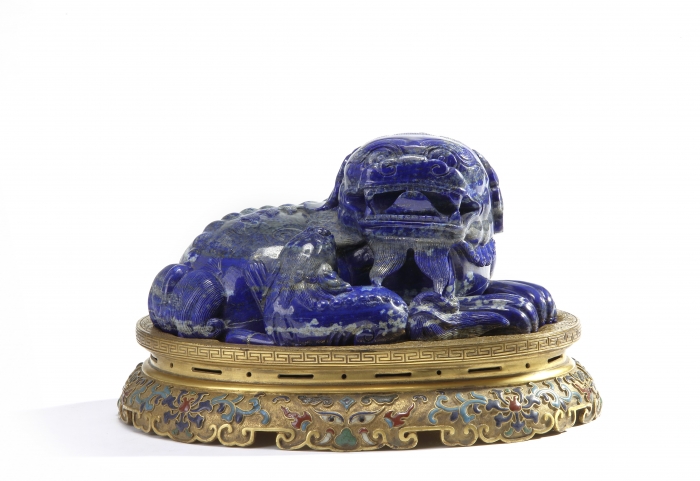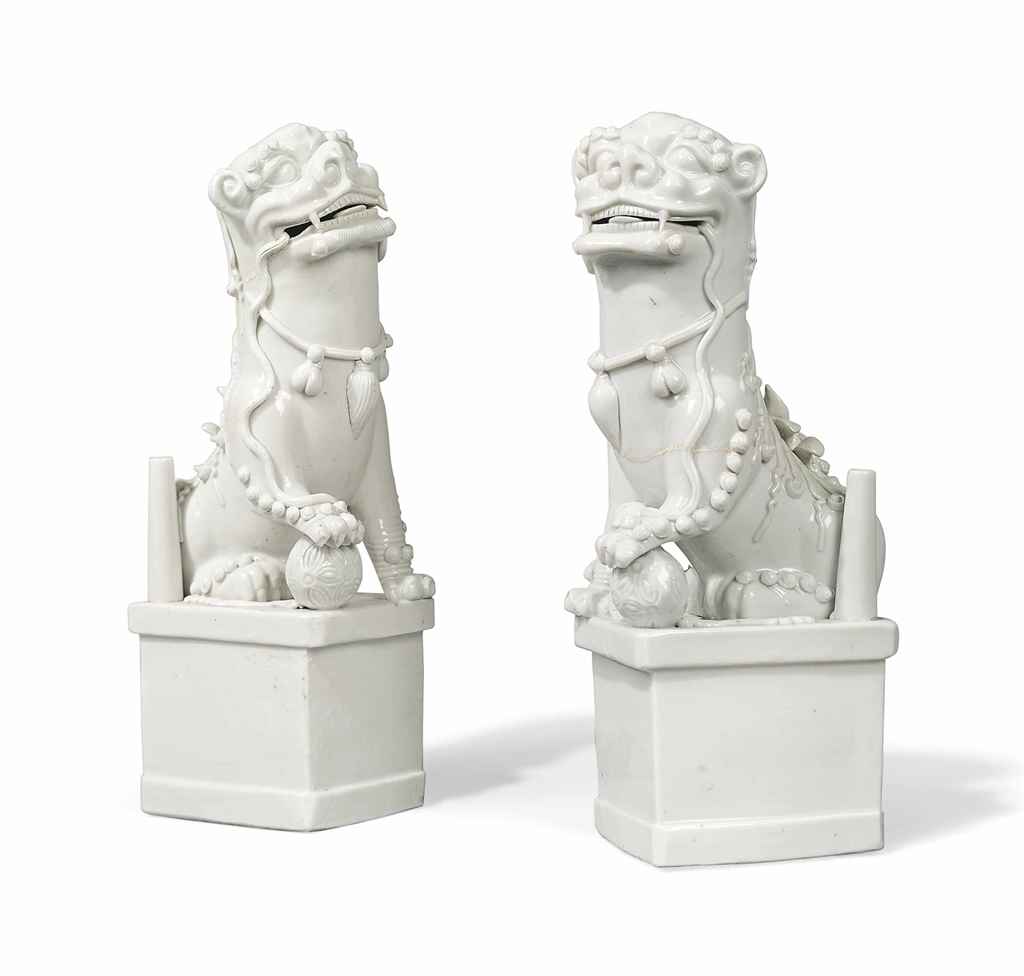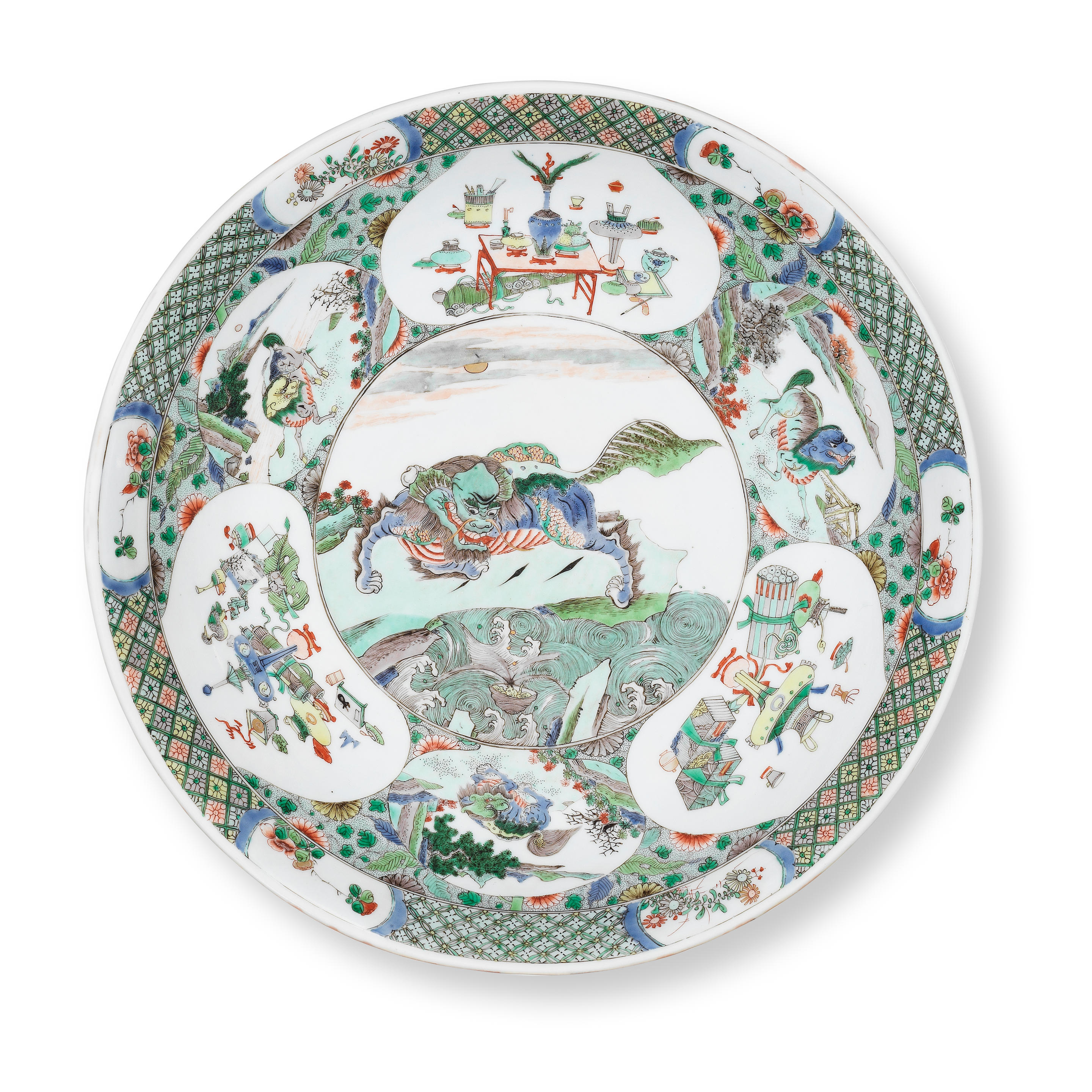Lot details China, 1644-1912, probably Qianlong, 1736-1795 (see expert’s note). The massive square seal is surmounted by a finely carved recumbent Buddhist lion, its head turned to the right, the tail swept to the left, and the right foot resting on a brocade ball. The ferocious face is finely detailed with its mouth slightly agape to reveal sharp fangs holding a ball. The opaque soapstone is of a dark-brown, almost jet-black tone with scattered beige inclusions. Inscriptions: The seal face incised in zhuan style with the Heart Sutra, the four sides showing the same text written in kai style. With apocryphal signature ‘Wen Peng’ and date of the 16th year of the Jiajing reign (corresponding to 1537). The inscription has an overall length of more than 500 neatly incised characters! Provenance: From the property of a French noble family, the collection formed by the owner's great-grandfather from the late 19th century to the early 20th century. Christie's Paris, 22 June 2016, lot 313, sold for EUR 27,500, or approx. EUR 31,000 (adjusted for inflation at the time of writing). A noted private collection, acquired from the above. Condition: Very good condition with fine old wear, few nicks and shallow surface scratches, minuscule chips to the edges. With a naturally grown patina and an unctuous feel overall, clearly the result of centuries-long handling. Weight: 1,412 g (incl. base) and 1,374 g (excl. base) Dimensions: Height 11.7 cm (incl. base) and 10.6 cm (excl. base) With a finely carved wood base supported on four short feet and with key-fret bands neatly incised to the sides, as well as an old rubbing of the seal face on paper. (3) The inscribed text is known as the Prajnaparamita sutra, or Heart Sutra, which was translated into Chinese in the 7th century by the pilgrim monk Xuanzang on the orders of the Emperor Gaozong (reigned 649-683 AD). One of the principal scriptures of the Madhyamika school of Buddhism founded by the great Buddhist philosopher Nagarjuna (c. 100-200 BC), the Heart Sutra expounds that through true wisdom, one may realize the emptiness of this world and so achieve Enlightenment. The Heart Sutra, propagating total denial of the reality of the phenomenal world, is one of the most important Mahayana texts and became a popular script for copying, probably partly due to its brevity. Such copying had the dual function of serving as a calligraphic exercise and representing an act of devotion. Wen Peng (1498-1573), a famous seal carver, was the eldest son of the artist Wen Zhengming. He was a native of Changzhou (Suzhou), Jiangsu, and the originator of the Sanqiao School, the first literati seal carving school. Expert’s note: The Qianlong Emperor was a devout Buddhist and is known to have himself copied the Heart Sutra countless times. He also ordered various objects - including seals - to be carved with the text, some of these bearing apocryphal dates as reference to earlier reigns. The Jiajing Emperor, however, was a devoted Daoist, morphing somewhat into a fanatic after an assassination attempt in 1542. The date on the present seal - 1537 - points to a time shortly before this event, when the Emperor already favored princes who were devout Daoists, granting the most fervent followers amongst them gifts and titles, therefore actively suppressing Buddhism. For these reasons, it seems more likely that the present seal was carved during the Qianlong era, and not in the Jiajing period, despite the fact that experts from Sotheby’s London have dated the present seal to the Ming Dynasty. 清代《般若波羅蜜多心經》獅鈕印 中國, 1644-1912年,可能為乾隆時期(1736-1795年,見專家注釋)。方形印章上有一頭雕刻精美的臥獅,它的頭右轉,尾巴左掃,右腳踩在一個錦球上。眼睛圓鼓,張開的嘴巴裏露出鋒利的尖牙。不透明的皂石呈深棕色,幾乎是烏黑的色調,帶有散落的米色内沁。 款識:印章面篆書《般若波羅蜜多心經》,四側面楷書同樣文字。文鵬款,嘉靖十六年 (1537年)。全文500多個字。 來源:法國貴族家族收藏,收藏由現主人的曾祖父建立於十九世紀末至二十世紀初;巴黎佳士得,2016年6月22日, lot 313, 售價27,500, 相當於現在的 EUR 31,000;知名私人收藏,購於上述拍賣。 品相:品相極好,有磨損,少量刻痕和表面淺劃痕,邊緣有微小的磕損。自然生長的光澤和包漿。 重量:1,412 克 (含底座) 與 1,374 克 (不含底座) 尺寸:高11.7 厘米(含底座) 與10.6 厘米(不含底座) 雷紋四足木底座。(3) 《般若波羅蜜多心經
Lot details China, 1644-1912, probably Qianlong, 1736-1795 (see expert’s note). The massive square seal is surmounted by a finely carved recumbent Buddhist lion, its head turned to the right, the tail swept to the left, and the right foot resting on a brocade ball. The ferocious face is finely detailed with its mouth slightly agape to reveal sharp fangs holding a ball. The opaque soapstone is of a dark-brown, almost jet-black tone with scattered beige inclusions. Inscriptions: The seal face incised in zhuan style with the Heart Sutra, the four sides showing the same text written in kai style. With apocryphal signature ‘Wen Peng’ and date of the 16th year of the Jiajing reign (corresponding to 1537). The inscription has an overall length of more than 500 neatly incised characters! Provenance: From the property of a French noble family, the collection formed by the owner's great-grandfather from the late 19th century to the early 20th century. Christie's Paris, 22 June 2016, lot 313, sold for EUR 27,500, or approx. EUR 31,000 (adjusted for inflation at the time of writing). A noted private collection, acquired from the above. Condition: Very good condition with fine old wear, few nicks and shallow surface scratches, minuscule chips to the edges. With a naturally grown patina and an unctuous feel overall, clearly the result of centuries-long handling. Weight: 1,412 g (incl. base) and 1,374 g (excl. base) Dimensions: Height 11.7 cm (incl. base) and 10.6 cm (excl. base) With a finely carved wood base supported on four short feet and with key-fret bands neatly incised to the sides, as well as an old rubbing of the seal face on paper. (3) The inscribed text is known as the Prajnaparamita sutra, or Heart Sutra, which was translated into Chinese in the 7th century by the pilgrim monk Xuanzang on the orders of the Emperor Gaozong (reigned 649-683 AD). One of the principal scriptures of the Madhyamika school of Buddhism founded by the great Buddhist philosopher Nagarjuna (c. 100-200 BC), the Heart Sutra expounds that through true wisdom, one may realize the emptiness of this world and so achieve Enlightenment. The Heart Sutra, propagating total denial of the reality of the phenomenal world, is one of the most important Mahayana texts and became a popular script for copying, probably partly due to its brevity. Such copying had the dual function of serving as a calligraphic exercise and representing an act of devotion. Wen Peng (1498-1573), a famous seal carver, was the eldest son of the artist Wen Zhengming. He was a native of Changzhou (Suzhou), Jiangsu, and the originator of the Sanqiao School, the first literati seal carving school. Expert’s note: The Qianlong Emperor was a devout Buddhist and is known to have himself copied the Heart Sutra countless times. He also ordered various objects - including seals - to be carved with the text, some of these bearing apocryphal dates as reference to earlier reigns. The Jiajing Emperor, however, was a devoted Daoist, morphing somewhat into a fanatic after an assassination attempt in 1542. The date on the present seal - 1537 - points to a time shortly before this event, when the Emperor already favored princes who were devout Daoists, granting the most fervent followers amongst them gifts and titles, therefore actively suppressing Buddhism. For these reasons, it seems more likely that the present seal was carved during the Qianlong era, and not in the Jiajing period, despite the fact that experts from Sotheby’s London have dated the present seal to the Ming Dynasty. 清代《般若波羅蜜多心經》獅鈕印 中國, 1644-1912年,可能為乾隆時期(1736-1795年,見專家注釋)。方形印章上有一頭雕刻精美的臥獅,它的頭右轉,尾巴左掃,右腳踩在一個錦球上。眼睛圓鼓,張開的嘴巴裏露出鋒利的尖牙。不透明的皂石呈深棕色,幾乎是烏黑的色調,帶有散落的米色内沁。 款識:印章面篆書《般若波羅蜜多心經》,四側面楷書同樣文字。文鵬款,嘉靖十六年 (1537年)。全文500多個字。 來源:法國貴族家族收藏,收藏由現主人的曾祖父建立於十九世紀末至二十世紀初;巴黎佳士得,2016年6月22日, lot 313, 售價27,500, 相當於現在的 EUR 31,000;知名私人收藏,購於上述拍賣。 品相:品相極好,有磨損,少量刻痕和表面淺劃痕,邊緣有微小的磕損。自然生長的光澤和包漿。 重量:1,412 克 (含底座) 與 1,374 克 (不含底座) 尺寸:高11.7 厘米(含底座) 與10.6 厘米(不含底座) 雷紋四足木底座。(3) 《般若波羅蜜多心經




.jpg?w=400)




.jpg)


.jpg?w=400?width=1600&quality=70)
Try LotSearch and its premium features for 7 days - without any costs!
Be notified automatically about new items in upcoming auctions.
Create an alert